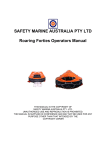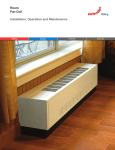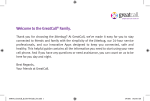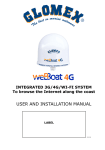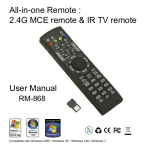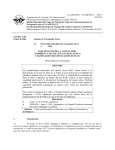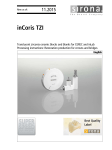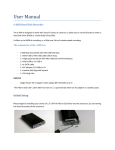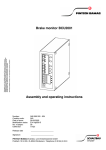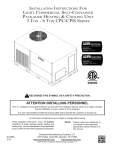Download Liferaft Owners Manual - Safetymarineaust.com.au
Transcript
SAFETY MARINE AUSTRALIA PTY LTD Roaring Forties Operators Manual THIS MANUAL IS THE COPYRIGHT OF SAFETY MARINE AUSTRALIA PTY. LTD. UNAUTHORIZED USE AND REPRODUCTION IS PROHIBITED. THE MANUAL IS SUPPLIED IN CONFIDENCE AND MAY NOT BE USED FOR ANY PURPOSE OTHER THAN THAT INTENDED BY THE COPYRIGHT OWNER SAFETY MARINE AUSTRALIA PTY LTD Roaring Forties Operators Manual SAFETY MARINE AUSTRALIA PTY LTD Roaring Forties Operators Manual RECORD OF CHANGE TO Roaring Forties Operators Manual ORIGINAL DATE –Sep-09 No Signature Document Approved by X Date DESCRIPTION OF CHANGE SAFETY MARINE AUSTRALIA PTY LTD Roaring Forties Operators Manual CONTENTS: SECTION 1. INTRODUCTION ................................................................................................ 1-1 SECTION 2. DESCRIPTION ................................................................................................... 2-1 SECTION 3. DESCRIPTION ................................................................................................... 3-1 SECTION 4. OCEAN PLUS LIFE RAFT SPECIFICATIONS .................................................... 4 SECTION 5. OPERATION ......................................................................................................... 5 SECTION 6. EQUIPMENT ......................................................................................................... 8 SECTION 7. LIMITATIONS ..................................................................................................... 7-1 SAFETY MARINE AUSTRALIA PTY LTD Roaring Forties Operators Manual OPERATOR’S MANUAL 04-25 PERSON LIFE RAFTS PART NUMBERS LIF3000 Series SECTION 1. INTRODUCTION 1.1.1 This manual has been prepared as a guide to the operations of the “Roaring forties” 4 to 25 person liferafts. 1.1.2 NOTE only Roaring Forties currently certificated Technicians are permitted to carry out any test, inspection, survey or service on or to any Roaring Forties, Safety Marine Australia or Dentrac Industries manufactured inflatable product and then only at Roaring Forties approved premises. 1.1.3 The location of approved premises can be obtained by contacting our sales office on Melbourne (03) 9555-5211 SAFETY MARINE AUSTRALIA PTY LTD Roaring Forties Operators Manual SECTION 2. DESCRIPTION 2.1.1 The range of liferafts have been so designed as to conform to the standards and regulations of A.A.P.M.A., AYF and from 2006 ISO9650., the rafts will accommodate from 4 to 25 persons. For coastal and 4 – 12 person for ISO 9650 2.1.2 The 4 to 10 person liferafts are similar in design and all consist of twin buoyancy chambers each capable of supporting the full complement of personnel. 2.1.3 An arch tube supports a single skin protection canopy, which is automatically erected by the inflation of the liferaft. The canopy has been designed with a single door entry for the 4 to 10 person liferafts and with two-door entry for the 12 to 25 person and ISO 9650 liferafts. The canopy is constructed in a highly visible colour with all weather protective closures. 2.1.4 The 12 to 25 person liferafts consist of twin buoyancy chambers each capable of supporting the full complement of personnel. The canopy is supported in the centre of the raft by means of a single inflatable strut, which is attached to the floor of the liferaft. 2.1.5 All liferafts are fully supplied with lifelines, sea anchor and other necessary items of equipment to the required scale. Major items in a typical emergency pack are shown in Table 1. The maximum life of perishable Emergency Items are set out in Table 2. 2.1.6 A safety knife is positioned inside the liferafts, attached to the buoyancy tube at a convenient position. This knife is to be used to cut the operating cord. 2.1.7 The complete liferaft assembly when deflated and folded is then packed into a rigid container or valise, sized accordingly to usage requirements. SAFETY MARINE AUSTRALIA PTY LTD Roaring Forties Operators Manual SECTION 3. DESCRIPTION 3.1 3.1.1 3.2 Proofed Fabrics Durable types, being single ply nylon, rubber proofed, resistant to abrasion, bacteria and other marine attack. Buoyancy chambers, arch and strut tubes 3.2.1 There are two buoyancy chambers inflated from one gas cylinder. The arch tube is inflated by gas passing from the upper chamber. The chambers and arch tube are made from a number of rubber compound nylon panels (FAB942) joined with a selfcuring rubber adhesive. The arch tube forms a support for the canopy when fully inflated. All rafts are equipped with topping up bellows as part of the standard equipment supplied. On 12 to 25 person liferafts, the canopy support strut is inflated by a feeder tube attached to the upper buoyancy. 3.2.2 Canopy 3.2.3 The canopy is constructed from a single skin nylon fabric, proofed and highly visible in colour. The upper edge of the canopy is attached to the arch tube and the lower edge of the canopy to the upper buoyancy chamber using a rubber adhesive. 3.2.4 Flooring 3.2.5 The floor is constructed from a single ply nylon material with a rubber compound outer proofing. Attached to the underside of the floor are lead ballasted stabiliser pockets, gas cylinder and battery pockets. 3.3 3.3.1 3.4 Boarding ladder A webbing boarding ladder and hauling in line are provided as standard equipment. A rescue line is attached to an internal lifeline loop inside the door entrance. Inflation system Series 3.4.1 The Gas inflation system consists of a cylinder connected by a high-pressure hose to an inflation tee-piece or tandem adaptor, which in turn is connected by an inflation valve to each buoyancy chamber. 3.4.2 The gas cylinder is fitted with an operating head and a remote control, which is usually a looped cable, coupled to the operating line of the liferaft. SAFETY MARINE AUSTTRALIA PTY LTTD F Operators Manuaal Roaring Forties 3.5 3.5.1 V Valves Buoyancy cchambers The following valve es are fitted d to the buoyancy: a)) One toppiing up valve e b)) Relief valvve is fitted externally e to o each buoyyancy cham mber. c)) One Gas inflation valve is fitted externally tto each buo oyancy cham mber. Figure e1 Figure 2 Top Up Valve V Ga as Inflation Inflation valve sy ystem Figure e3 Deflate Probe P Figure 4 Relief valve v SAFETY MARINE AUSTTRALIA PTY LTTD F Operators Manuaal Roaring Forties 3.5.2 Operating H Head 3000 Series a)) The opera ating head is i part of the e inflation ssystem for Y.A. Y and Co oastal marin ne liferafts. b)) The head consists off a main bod dy housing a pulley, which is attacched at one e end of the operating cable by b means off a ferrule. Inside I the pulley p is a hexagonal spindle incorporatting a quickk start thread. The spin ndle when ro otated deprresses the cylinder c valve belo ow it. c)) The opera ating head is i attached to the bottle e valve with h a clamp. W When the la anyard is pulled with a load of 65 newtonss or more th he operating g head operrates the cy ylinder valve. The e operation is achieved d by the lan nyard movin ng a pulley w within the de evice, which afte er the lanya ard has been n pulled outt 20 mm, re eleases a sp pring-loaded d plunger. This plung ger strikes the t burst dis sc cutter on n the cylinde er valve, wh hich then pe enetrates the burst disc releasiing the gas.. 3.5.3 Operating ssystem 9000 series a)) . The Ope erating Head is activate ed by pulling the Actua ator Cable w with a pull fo orce between 80N 8 and 110 0N over a minimum m 25m mm distance e. b)) Direction of pull can be up to 90 0° in any dirrection from m axis of cab ble exit. c)) The Actu uator Cable Assembly will w pull free e from the Operating O Head. d)) Gas discharge will be b through Cylinder C Valve outlet port to conne ecting hose e. 3 3000 Serie es Operatin ng System 9000 Series S Ope erating Sysstem Figure 5 Operating head and va alve assemblyy SAFETY MARINE AUSTRALIA PTY LTD Roaring Forties Operators Manual SECTION 4. OCEAN PLUS LIFE RAFT SPECIFICATIONS ISO9650 Type 1 Group A YACHTING AUSTRALIA COMPLIANT (CONTAINER - HARD PACK) 4 Person Weight: Approximately 52 kg Dimension: 320 x 590 x 840mm Life Raft Floor Surface Area: in excess of 1.5m² USL COASTAL COMPLIANT (CONTAINER - FLAT) 4 Person Weight: Approximately 52 kg Dimension: 320 x 590 x 840mm Life Raft Floor Surface Area: in excess of 1.5m² 6 Person 6 Person Weight: Approximately 57 kg Dimension: 320 x 590 x 840mm Weight: Approximately 57 kg Dimension: 320 x 590 x 840mm Life Raft Floor Surface Area: in excess of 2.3m² Life Raft Floor Surface Area: in excess of 2.3m² 8 Person 8 Person Weight: Approximately 62 kg Dimension: 385 x 590 x 840mm Weight: Approximately 62 kg Dimension: 385 x 590 x 840mm Life Raft Floor Surface Area: in excess of 3.0m² Life Raft Floor Surface Area: in excess of 3.0m² 10 Person 10 Person Weight: Approximately 67 kg Dimension: 385 x 590 x 840mm Life Raft Floor Surface Area: in excess of 3.72m² Weight: Approximately 67 kg Dimension: 385 x 590 x 840mm Life Raft Floor Surface Area: in excess of 3.72m² (VALISE - SOFT PACK) 4 Person Weight: Approximately 35 kg Approximate Dimension: 650 x 420mm (dia.) Life Raft Floor Surface Area: in excess of 1.5m² (CONTAINER - ROUND) 12 Person Weight: Approximately 87 kg Approximate Dimension: 1245 x 485mm (dia.) Life Raft Floor Surface Area: in excess of 4.46m² 6 Person 15 Person Weight: Approximately 41 kg Approximate Dimension: 820 x 420mm (dia.) Life Raft Floor Surface Area: in excess of 2.3m² 8 Person Weight: Approximately 48 kg Approximate Dimension: 900 x 460mm (dia.) Life Raft Floor Surface Area: in excess of 3.0m² 10 Person Weight: Approximately 55 kg Approximate Dimension: 920 x 480mm (dia.) Life Raft Floor Surface Area: in excess of 3.72m² Weight: Approximately 105 kg Approximate Dimension: 1370 x 535mm (dia.) Life Raft Floor Surface Area: in excess of 5.58m² 20 Person Weight: Approximately 130 kg Approximate Dimension: 1525 x 535mm (dia.) Life Raft Floor Surface Area: in excess of 7.44m² 25 Person Weight: Approximately 155 kg Approximate Dimension: 1525 x 535mm (dia.) Life Raft Floor Surface Area: in excess of 9.3m² SAFETY MARINE AUSTRALIA PTY LTD Roaring Forties Operators Manual SECTION 5. OPERATION NOTE: The following operational procedure illustrates one possible evacuation method since individual operators may develop procedures tailored to their specific modes of operation. 5.1 RAFT 5.1.1 After the decision to leave the vessel the liferaft needs to be deployed come to a complete stop, 5.1.2 Take care to ensure that no sharp objects that could puncture the inflating raft are in the area. 5.1.3 Ensure the liferaft operating/painter line is secured to the vessel 5.1.4 Throw liferaft into the water 5.1.5 Pull out approximately 9 metres of slack lanyard until taught, and then pull firmly until inflation occurs. The valise will open and the buoyancy tube will inflate in approximately 10 to 30 seconds. 5.1.6 After the raft is inflated, utilize the retaining line to position the raft for boarding. 5.1.7 CHECK THE PROPER FUNCTIONING OF THE LIFERAFT. Check that the top and bottom buoyancy and centre strut, or arch tube, are inflated. 5.1 5.1.1 Get away from sinking craft Use paddles. Also use drogue by rolling into a ball and throw in direction required. Then haul on drogue line. Look for and rescue survivors. Use rescue line and quoit. Throw to survivor or pass quoit over arm and swim to survivor. Lift unconscious survivor under armpits and slide backwards into liferaft SAFETY MARINE AUSTRALIA PTY LTD Roaring Forties Operators Manual 5.1.2 Collect useful items. Clothing, blankets, etc. Haul in emergency pack if it is not inside the liferaft. 5.1.3 Keep all liferafts together. To reach other liferafts use paddles and drogue as described above. 5.1.4 5.2 5.2.1 Activate EPIRB if available SUBSEQUENT ACTION Tend injured survivors Keep them as warm and dry as possible. If an emergency pack is fitted a first aid kit will be inside. 5.2.2 Dry the liferaft floor. Use baler and sponge pads. 5.2.3 Inflate floor in cold conditions. If inflatable floor is installed inflate floor through valve with bellows. (All ISO Compliant raft have a foam insulated floor this action would not be required) 5.2.4 Adjust doorway/s to suit conditions. Details on last pages 5.2.5 Stream drogue If not in use pull rolled drogue from ties. Throw into sea. 5.2.6 Open emergency pack. Familiarise yourself with the contents. 5.2.7 Check the canopy light. If it is not alight check the connection of the cell. The cell life is about 14 hours. Save current during daylight hours by pushing the activator switch in. 5.2.8 Ensure adequate ventilation at all times. Yawning and lack of energy indicate the need for fresh air. SAFETY MARINE AUSTRALIA PTY LTD Roaring Forties Operators Manual Stability Keep the raft balanced by distributing occupants evenly. No one should stand up in the raft. In case of capsizing keep life vests on (if available). In rough water, keep at least one occupant tied to the raft with a minimum of ten feet of line (if available) so that in the event of capsizing at least one person can easily retrieve and right the raft, then retrieve the other persons. Children should always be tied to an adult. Keeping Warm Use the bailing bucket and sponge (if available) to keep the raft dry and clean since sitting in water soon creates water sores that are painful and can infect easily. Dry your clothes off as best as possible by wringing and airing since wet clothing will detrimentally reduce body heat in cold weather. Be sure to restore and secure equipment immediately after use since items are easily lost overboard, especially in rough water. Be especially careful with items that could puncture or tear the raft. Do not throw anything away since you may find a need for used items somewhere down the line. For example, empty cans and plastic bags can hold rain water, and metal bands from opened cans may be utilized as fish books. Maintain protection from the elements as much as possible. Keep your clothing on even if it’s hot. Rest as much as you can, especially in the hot part of the day. Exercise daily in your limited space by isotonic ally flexing muscles and wiggling fingers and toes. Be optimistic and keep a sense of humour. Food and water Rationing Water is the key to survival at sea. Body water loss through sweating, urinating, and vomiting is as important as drinking water. Therefore, do as little as possible during hot hours, work at a slow pace when necessary, and take immediate action against seasickness by stretching out on the raft deck and being as still as possible. DO NOT RATION WATER. Drink as much as you need when you’re thirsty, then RATION YOUR SWEAT. You need enough water to remain at a good energy level to help yourself, and sipping water weakens you much faster through dehydration. Care of the raft The pressure in the raft flotation tube will fluctuate with the temperature. In hot weather, extra pressure will be relieved by the pressure relief valves on the exterior of the raft. In cool weather and at night the raft pressure can be increased by utilizing the hand pump at the inflation valve. Normally, sharks may investigate your raft and go away without bothering you. Do not dangle hands and/or feet in the water or dispose of raw vomit or body wastes in the water since these may attract and excite sharks. Plastic bag (if possible) vomit and/or body wastes and throw them away from the raft. Search and rescue teams are looking for you. Normally rescue teams will locate you within 12 to 24 hours. When they do arrive, do what they tell you and let them take care of you. They know what to do and will be more aware of your condition than you will. SAFETY MARINE AUSTRALIA PTY LTD Roaring Forties Operators Manual SECTION 6. EQUIPMENT STANDARD EQUIPMENT (Cruising Pack) ITEM Seasick Bags Bailer QUANTITY 1 Per Person 1 Air Bellows 1 Rescue Signal Card 1 Sea Drogue(Sea Anchor) 1 Heliograph (Signal Mirror) 1 Fishing Kit Adhesive Repair Kit Immediate Action Leaflet Rescue Line & Quoit (Throwing Ring) 1 1 1 Paddles The bailer is fabricated of nylon. Use the bailer to remove water from the raft as required to keep it as dry as possible. The hand pump is a dual action pump and is used for topping off the flotation tubes in the event of pressure loss during temperature changes or extended use. Push the pump fitting into the inflation valve until it is firmly attached. Pump until the tube is fully inflated (no wrinkles), close inflation valve. The sea anchor is attached to the lifeline on the raft and helps to keep an empty raft from being capsized by wind. Although you want to be far enough away from the vessel so that neither will damage the raft, you want to remain in the immediate area in order that rescue searchers can find you sooner. If you have to speed up drift to get to a survivor or an object in the water, pull in the sea anchor, then throw it back out after you have drifted the necessary distance Use the signal mirror when you are in doubt about a craft’s ability to see your signal flare. It can be used indefinitely. Mirror flashes can be seen about 20 miles, so the mirror should be in constant use during daylight, sunny hours. Sweep the horizon, flashing the mirror. Each person should take a turn at this. Keep the mirror surface as clean and fingerprint free as possible. 1 1 pair Sponges 1 Per Person Leak Stoppers 1 set Torch & Batteries with spare bulb 1 The hand paddles can be used to paddle the raft close to retrievable persons in the water or to paddle toward land or rescue craft. The dehydrated/compressed sponge takes up very little space in the equipment kit and can be used along with the bailing bucket to keep the raft floor dry. The flashlight can be seen about 3nm on an open sea. During the first night flash SOS (3 short, 3 long, 3 short), sweeping the sky. For nights after SAFETY MARINE AUSTRALIA PTY LTD Roaring Forties Operators Manual Rescue Whistle 1 the first, use the flashlight signal only when you hear an aircraft or see a ship’s lights. The whistle is used to signal other rafts, survivors, and assist rescue searchers in locating you at night or in the fog. Use it to signal SOS (3 short, 3 long, 3 short) when visibility is limited. Rotate this responsibility among the raft occupants EMERGENCY EQUIPMENT SCHEDULE 04 – 10 PERSON EQUIPMENT B.O.T.S.C. RESCUE TABLE BAILER DRINKING VESSEL FIRST AID KIT FLOATING KNIFE HELIOGRAPH 100MM LIFERAFT INSTRUCTION SHEET PADDLES REPAIR KIT RESCUE LINE AND QUOIT RESCUE WHISTLE RUBBER BUNGS SAFETY CAN OPENER (IF WATER IN TINS) SEA ANCHOR SEA SICK TABLETS SPONGE TOPPING UP BELLOWS TORCH, SPARE BATTERIES (2) AND GLOBE WHISTLE LIFERAFT SURVIVAL INSTRUCTION SHEET QUANTITY 1 1 1 1 1 1 1 2 1 1 1 2 2 1 6 PER PERSON 1 PER PERSON 1 1 1 1 SAFETY MARINE AUSTRALIA PTY LTD Roaring Forties Operators Manual EMERGENCY EQUIPMENT SCHEDULE U.S.L. COASTAL AND A.Y.F REGULATIONS EQUIPMENT CHEMICAL LIGHTS EMERGENCY RATION PACKS 500GM U.S.L. COASTAL REGS 6 1 PER PERSON A.Y.F. N/R 1 PER PERSON 1 N/R FISHING KIT (WITH HOOKS) HAND RED FLARES LEAK STOPPER SET (No 1,3,5) ORANGE SMOKE FLARES PARACHUTE FLARES PLASTIC BAGS 2 1 4 2 1 N/R 1 PERSON SUNBURN CREAM WATER PROOF MATCHES WATER SACHETS OR TINS 500ML N/R 25 2 PER PERSON 2 2 5 PER PERSON 2 N/R 1 PER PERSON . Food rations consist of fortified, high calorie, compact, baked bars specifically formulated to provide a balanced diet with limited drinking water availability. The contents of each food packet are designed to feed four persons for one day or one person for four days. Water rations are packaged in durable foil bags. Utilise this drinking water as specified in the OPERATIONS SECTION of this MANUAL SECTION 7. LIMITATIONS All rafts shall be stowed in a clean dry, contaminant free area away from any heat source. Contaminants such as petroleum solvents, fuel, grease, oil, or hydraulic fluids may have a detrimental effect on the fabrics and consequently on the life and performance of the raft. The stowage area should be at least equal in size to the complete raft assembly. Following are storage and operational temperature limits for the rafts: OPERATING and/or STORAGE -15 C to +60 C SERVICNG PERIODS Under normal conditions, life rafts shall be removed from their container/valise and inspected in accordance with Safety Marine Australia’s Service Manual at regular intervals not to exceed 12 months for Coastal and Yachting Australia Packs and 24 months for Standard Equipment Cruising Packs. Inspection consists of removing the raft from its container, conducting an pressure test, weight checking the CO2 inflation system cylinder, visually checking the raft for tears, cuts, punctures, abrasions, and deterioration, and then repacking the raft. Safety equipment (if included) shall be removed and inspected and visually checking each item for condition and life limitation. Cylinder hydro test is required every five years at which time the valve is overhauled and the cylinder then freshly charged. SAFETY MARINE AUSTRALIA PTY LTD Roaring Forties Operators Manual SAFETY MARINE AUSTRALIA PTY LTD Roaring Forties Operators Manual





















